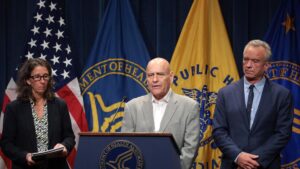Here is the chancellor of the exchequer, Nadhim Zahawi, commenting on the data, repeating his line from yesterday.
I understand that times are tough, and people are worried about increases in prices that countries around the world are facing.
Although there are no easy solutions, we are helping where we can through a ?37bn support package, with further payments for those on the lowest incomes, pensioners and the disabled, and ?400 off energy bills for everyone in the coming months.
Getting inflation under control is my top priority, and we are taking action through strong, independent monetary policy, responsible tax and spending decisions, and reforms to boost productivity and growth.
Restaurant and hotel prices roses by 9% in the year to July, the highest rate ever recorded, mostly at hotels, while fast food takeaway and pub meals also became dearer.
Prices for clothing and footwear fell by less than last year, as retailers discounted less in the summer sales, in particular for women’s clothes and shoes and infants’ clothes while menswear prices fell by more than a year ago.
Transport costs rose at an annual rate of 15.1%, down from 15.2% in June. Fuel prices, air fares and international rail tickets went up in price between June and July, with fuel prices up by 43.7% in the year to July, the highest rate recorded.
The ONS explained:
Following June’s record increase to petrol prices, weekly forecourt prices had started to fall during July. However, the gradual reduction still left July’s average prices for petrol and diesel both 5.5 pence per litre higher than in June. Average petrol and diesel prices stood at 189.5 and 197.9 pence per litre, respectively, in July 2022, compared with 132.6 and 135.5 pence per litre a year earlier.
Electricity prices jumped by 54% and gas prices by 95.7% in the 12 months to July (and there is much more pain to come).
“Recreation and culture” is another area where prices rose (by 5.6%), for pet food, recording media, package holidays, and games, toys and hobbies, among other items. This was partly offset by a fall in the price for potted shrubs.
Other small upward contributions to the inflation rates came from appliances and products for personal care: toilet rolls, toothbrushes, hair straighteners and deodorants became more expensive between June and July, compared with price falls this time last year.
Prices for housing and household services rose by 9.1% in the year to July, mainly because of owners’ housing costs and higher social rents. This is not included in the headline CPI measure, but in the CPIH measure that includes housing.
The main culprit behind the rise in inflation were higher food prices, which rose at an annual rate of 12.7% in July, up from 9.8 in June. The ONS said:
The largest upward contributions (of 0.04 percentage points) came from bread and cereals, and from milk, cheese and eggs – where prices for shop-bought and delivered milk, cheddar cheese and yoghurts (or fromage frais) increased notably. Other smaller effects (of 0.03 percentage points) came from meat (notably from cooked ham and bacon), vegetables including tubers, and sugar, jam, syrups, chocolate and confectionery.
UK inflation hit 10.1% in July, up from 9.4% in June, according to the Office for National Statistics. The figure was last higher in February 1982. Economists had forecast a rise to 9.8%.
The core rate, which strips out volatile items like food and energy, rose to 6.2% from 5.8%, and was also higher than expected.
In New Zealand, the central bank has raised interest rates for the seventh time and signalled a more aggressive path over coming months to rein in high inflation.
The aggressive tone of the Reserve Bank of New Zealand’s statement warning of future rate hikes caught some traders by surprise and lifted the local dollar.
The RBNZ raised the official cash rate by 50 basis points to 3% as expected, a level last seen in September 2015. It now projects rats at 4% by early next year, rather than 3.7% as previously signalled. Rates have been raised from a record low of 0.25% in October.
It said:
The committee agreed that domestic inflationary pressures had increased since May and to further bring forward the timing of OCR increases.
Michael Hewson, chief market analyst at CMC Markets UK, said:
Having hit another record high of 9.4% in June, today’s UK CPI numbers look set go higher, perhaps even reaching 10%, as rising prices become more entrenched.
Now that the Bank of England has belatedly recognised that more needs to be done to try and counter the surge in prices by raising rates by 50bps earlier this month, another strong number today will probably seal the prospect of another 50bps rate rise in September.
It is true that there is little the central bank can do about the rise in food and energy prices, however even with food and energy stripped out, core prices are still well above the banks headline target of 2%, and with companies now starting to pass price rises on, inflation is beginning to become much stickier.
It’s also an important day for US markets with questions continuing to get asked about the resilience of the rebound off the June lows. Today we have the latest retail sales numbers for July and the latest FOMC [Federal Open Market Committee] minutes.
With the US economy now confirmed to be in a technical recession, one area that has been shown to be quite resilient has been the US consumer.
US retail sales have been positive every single month this year, apart from a modest 0.1% fall in May. If higher prices are deterring consumer spending, it’s not immediately obvious in these numbers.
Good morning, and welcome to our live, rolling coverage of business, economics and financial markets.
It’s inflation day in the UK. The consumer prices index is forecast to have risen by 9.8% in the 12 months to July, approaching double digits. In June, the annual rate reached 9.4%, the highest in four decades.
The Bank of England expects inflation to hit 13.3% in October when the energy price cap is due to rise again, raising household bills for millions of people.
Economists are forecasting that the core inflation rate, which strips out volatile items like food and energy, ticked up to 5.9% last month from 5.8% in June. The figures will be released by the Office for National Statistics (ONS) at 7am BST.
Investec economist Sandra Horsfield said:
UK consumer price inflation has been on a relentless upward path: since breaching the 2% target – in May 2021 – there have only been two months in which the annual inflation rate has slipped vis-?-vis the previous month.
A series of shocks have brought this about. First, the disruption to production and distribution in response to Covid, against a backdrop of maintaining demand through government fiscal support, put pressure on goods prices. Second, the unlocking of certain sectors such as hospitality, prompted the release of pent-up demand and savings in sectors where labour markets had become very tight. And third, already tight commodity markets were squeezed substantially as a result of Russia’s invasion of Ukraine – particular pinch points being natural gas and, this being the marginal fuel for electricity generation, power prices, as well as food.
She said there are some signs that the long-awaited easing in supply chain disruptions may have begun, but noted that the surging cost of energy – up 57.3% year-on-year in June – shows no sign of abating.
Nor has services price growth cooled as yet as labour markets are still very tight. For July, we anticipate yet another move higher in the annual inflation rate to have taken place, to 9.7%. Although the easing in supply chain pressures may have contained core inflation, which we expect to have nudged up only marginally, to 5.9%, higher food prices in particular may have made a mark on headline inflation.
In time, the softening in global commodity markets could help price pressures to diminish – as would a weakening in the labour market, as the Bank of England’s rate rises start to crimp aggregate demand.
But unless the ONS decides that government mitigation can count as an offset in CPI inflation, the further surge in the energy cap that looks all but baked in for October could push headline price rises to well over 12% come early Q4. In other words, the cost of living crisis is far from over, as is the pressure to help households struggling to afford essentials as a result.
It’s a different picture in the US, where inflation slowed more than expected last month to 8.5% from June’s four-decade high of 9.1%, reflecting lower energy and gasoline costs, while the core rate remained at 5.9%. In Canada, inflation also eased, for the first time in a year, to 7.6% from 8.1% in June, official figures showed yesterday.
The Agenda
10am BST: Eurozone GDP growth for the second quarter (second estimate) (forecast: 0.7%)
1.30pm BST: US Retail sales for July (forecast: 0.1%)
7pm BST: US Federal Reserve (FOMC) minutes of last meeting





